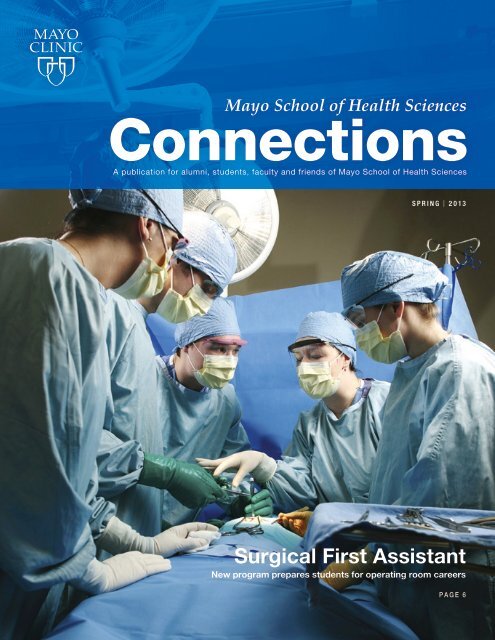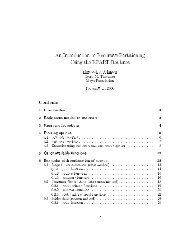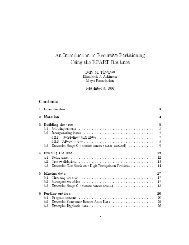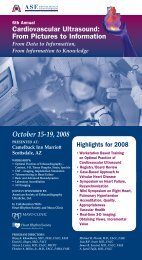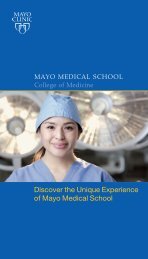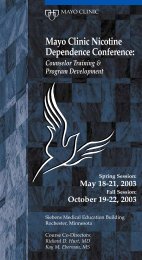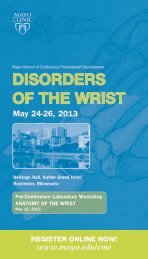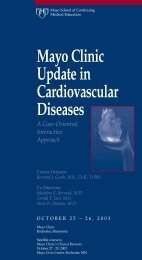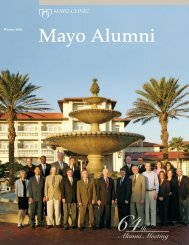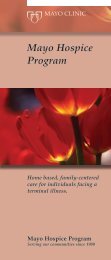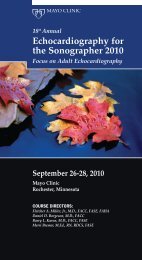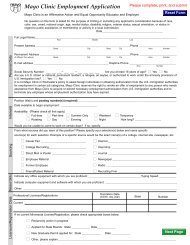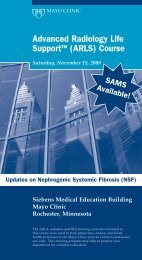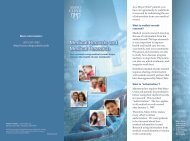Spring 2013 - Mayo Clinic
Spring 2013 - Mayo Clinic
Spring 2013 - Mayo Clinic
Create successful ePaper yourself
Turn your PDF publications into a flip-book with our unique Google optimized e-Paper software.
<strong>Mayo</strong> School of Health Sciences<br />
Connections<br />
A publication for alumni, students, faculty and friends of <strong>Mayo</strong> School of Health Sciences<br />
SPRING | <strong>2013</strong><br />
Surgical First Assistant<br />
New program prepares students for operating room careers<br />
PAGE 6
Change — The new comfort zone<br />
This spring, hundreds of <strong>Mayo</strong><br />
School of Health Sciences students<br />
are making final preparations for their<br />
postgraduate careers.<br />
This juncture is a joyous time of<br />
anticipation and congratulations, as<br />
well as a gateway to considerable<br />
personal change. For graduates,<br />
the structure of routine is upended,<br />
co-workers are new, and countless<br />
unfamiliar rules for survival and<br />
success are encountered.<br />
For all of us, new graduates and<br />
seasoned professionals, change is<br />
everywhere. The environment of<br />
scientific discovery and politics is<br />
evolving at a breathtaking rate. The<br />
U.S. health care system is on the<br />
threshold of a gigantic evolutionary<br />
leap. Our success, and that of our<br />
health care organizations, is built<br />
on a foundation of accepting this<br />
changing world.<br />
In 1930, Charles <strong>Mayo</strong>, MD,<br />
said, “Today the only thing that is<br />
permanent is change.” Eighty years<br />
later, those words are just as relevant.<br />
But many of us naturally react to<br />
something unfamiliar and different<br />
with resistance. What a paradox.<br />
All of us embraced the unknown<br />
and unfamiliar by pursuing a lifechanging<br />
career in health sciences.<br />
Yet after we are established,<br />
moving away from the status quo<br />
is uncomfortable.<br />
Challenge yourself to reframe<br />
change as the new comfort zone.<br />
Knock down your mental barriers.<br />
Explore opportunities to do things<br />
differently. It could be a path to<br />
improve your work or personal life,<br />
as well as the lives of your patients,<br />
co-workers and families. So much<br />
is possible when the internal chants<br />
of “can’t, won’t and don’t want to”<br />
are silenced.<br />
“Today the only thing that is<br />
permanent is change.”<br />
– CHARLES MAYO, MD<br />
This year is the 40th anniversary of<br />
<strong>Mayo</strong> School of Health Sciences. And<br />
2014 will be the 150th anniversary<br />
of the founding of <strong>Mayo</strong> <strong>Clinic</strong>. The<br />
long, successful history of <strong>Mayo</strong> <strong>Clinic</strong><br />
and our school are the result of many<br />
talented individuals who embodied<br />
personal discovery, compassion and<br />
ongoing transformation.<br />
Explore, transform and embrace<br />
change — no matter where you are<br />
on your career path. Earning your<br />
degree or completing an education<br />
program is just the beginning. C<br />
Caren Hughes, PharmD<br />
President, <strong>Mayo</strong> School of Health<br />
Sciences Alumni Association<br />
<strong>Clinic</strong>al Pharmacy Specialist,<br />
The University of Texas<br />
MD Anderson Cancer Center<br />
ON THE COVER<br />
Students in the new Surgical First Assistant Program train in the Multidisciplinary Simulation Center.
SPRING | <strong>2013</strong><br />
<strong>Mayo</strong> School of Health Sciences<br />
Connections<br />
16 Great (safety) catch<br />
MRI technologists spot metal<br />
in patients’ bodies. Their diligence<br />
helped avoid potential harm.<br />
2 Inspiring the next<br />
generation<br />
Job shadow student now colleague<br />
4 Coaching for success<br />
New resources for students<br />
6 Surgical First Assistant<br />
New program for<br />
operating room careers<br />
8 Mark Warner, MD<br />
Executive dean for Education<br />
shares his vision<br />
9 See you April 26<br />
Alumni meeting program features<br />
technology wonders<br />
10 NP/PA Fellowship<br />
Addressing shortage of<br />
critical care providers<br />
11 Starting over<br />
Phlebotomy alumnae in<br />
second medical careers<br />
12 Audiologist Sarah Oakley<br />
“Magnet for students,<br />
excellent teacher”<br />
13 Student research<br />
Presenting in France, questioning<br />
status quo, and better understanding<br />
the spread of cancer<br />
18 In the news<br />
New student record system;<br />
program director with<br />
decorating flair
Inspiring the<br />
next generation<br />
WARNING: PASSION FOR YOUR HEALTH-SCIENCE CAREER MAY BE CONTAGIOUS.<br />
Exhibit A: Several years ago, Mike<br />
Davis, RDCS, a cardiac sonographer<br />
with <strong>Mayo</strong> <strong>Clinic</strong> Health System<br />
(MCHS) in Eau Claire, Wis., allowed<br />
a high school sophomore to shadow<br />
him on the job. The student,<br />
Brigitte Rediger, was intrigued<br />
and eventually enrolled in the<br />
MSHS Echocardiography Program<br />
in Rochester, Minn. Today, she is<br />
Davis’ colleague.<br />
“Brigitte has been such a wonderful<br />
addition to our department,” Davis<br />
says. “She’s a great technician and<br />
co-worker, and she’s really good<br />
with patients. I feel absolutely terrific<br />
that I had an influence on her career<br />
choice. I’m very proud that I touched<br />
somebody’s life, and we’re all<br />
benefiting — our department, MCHS<br />
and our patients.”<br />
Opening eyes to career options<br />
Davis and Arlyn Rediger, Brigitte’s<br />
father, have been friends since<br />
high school in Bloomer, Wis. After<br />
Davis joined the U.S. Navy, the two<br />
stayed in touch. Davis trained in<br />
echocardiography at the Naval School<br />
of Health Science in San Diego, Calif.,<br />
and rose to the rank of chief petty<br />
officer at the Naval Hospital at Camp<br />
Pendleton, Oceanside, Calif. He<br />
retired from the Navy in 2001, moved<br />
back to Wisconsin and joined the<br />
echocardiography staff in Eau Claire.<br />
“One day Arlyn called me out<br />
of the blue,” Davis recalls. “His<br />
daughter had to shadow so many<br />
people for a class on careers, and<br />
he asked if there was any way she<br />
could watch me do my job.”<br />
On a day that Davis worked<br />
outreach at the hospital in Bloomer,<br />
Brigitte Rediger spent a half-day<br />
watching and listening as Davis<br />
introduced her to ultrasound imaging<br />
of the human heart.<br />
“It is a great job,” Davis says.<br />
“We get a real-time view of the heart.<br />
We see how the valves function and<br />
can even see the blood flow.”<br />
With the patient’s permission,<br />
Rediger sat in on an echo exam.<br />
“I absolutely fell in love with the<br />
occupation — the technology, getting<br />
to spend an hour with the patient,<br />
interacting with the doctor, and<br />
seeing the heart live,” Rediger recalls.<br />
“I knew I wanted to do something in<br />
health care. Mike made the job sound<br />
and look exciting.”<br />
Career path leads home<br />
While attending MSHS, Rediger<br />
worked weekends as a certified<br />
nursing assistant at a MCHS nursing<br />
home in Bloomer, which gave her<br />
and Davis an occasional chance to<br />
“talk shop.”<br />
“Helping her was easy,” Davis<br />
says. “She’s smart. I could see<br />
2<br />
MSHS CONNECTIONS | SPRING <strong>2013</strong>
Cardiac sonographers Mike Davis<br />
and Brigitte Rediger are colleagues<br />
at <strong>Mayo</strong> <strong>Clinic</strong> Health System in<br />
Eau Claire. Rediger first learned<br />
about echocardiography when she<br />
shadowed Davis on the job for a<br />
high school class assignment.<br />
that she got what we do to assess<br />
cardiovascular anatomy.”<br />
After completing the Echocardiography<br />
Program in February<br />
2011, Rediger joined the <strong>Mayo</strong> <strong>Clinic</strong><br />
Echocardiography Lab in Rochester,<br />
one of the largest echo laboratories<br />
in the world. As one of about 90<br />
cardiac sonographers, she helped<br />
the lab perform more than 250<br />
echocardiographic procedures a day.<br />
Because her heart remained in her<br />
hometown, Rediger asked Davis to<br />
keep her in mind for any openings.<br />
In January 2012, she transferred to<br />
MCHS, where she is one of eight<br />
cardiac sonographers in Eau Claire<br />
and works at the hospital in Bloomer<br />
about one day a month.<br />
“I wanted to stay in the <strong>Mayo</strong><br />
system. I feel proud of the <strong>Mayo</strong><br />
name and our high standards of<br />
patient care,” Rediger explains.<br />
“And now I get to provide quality<br />
echocardiograms for people in the<br />
community that I grew up in.<br />
“In this job, you learn something<br />
new every day. There are challenges<br />
every day. And it’s always rewarding.<br />
I know I made the right choice.” C<br />
ARE YOU CONTAGIOUS?<br />
Health care needs good people.<br />
If you love your profession, pass<br />
it on. Contact the program you<br />
attended or your professional<br />
association about opportunities<br />
to share your knowledge and<br />
experience with students.<br />
Helping others discover lab careers<br />
Meghan Phelan, MLS, has great sense of purpose in her work as a medical<br />
technologist in the Blood Bank and Transfusion Medicine Department at<br />
<strong>Mayo</strong> <strong>Clinic</strong> hospital in Jacksonville, Fla., and she’s eager to share her outlook.<br />
“I work with transplant teams. I work on a lot of transfusions for the OR.<br />
I’m also trained on cell therapy,” Phelan says. “It’s a great work environment.<br />
It’s very fast-paced. I get a feeling of accomplishment because I’m<br />
making a difference.”<br />
Because of that passion for her profession, the American Society for <strong>Clinic</strong>al<br />
Pathology (ASCP) selected Phelan for its Career Ambassador Program in 2012.<br />
In the last three months of the year, she visited 11 Jacksonville-area science<br />
classes and staffed a booth at a career fair to make high school students aware<br />
of the critical role of lab professionals in health care. She plans to visit more<br />
classrooms in <strong>2013</strong>, including the high school she attended.<br />
Phelan feels qualified to be a career ambassador because she would have<br />
benefited from exposure to the laboratory field earlier in her school career.<br />
After completing a bachelor’s degree in biology from the University of Florida,<br />
she was undecided on which field to enter.<br />
“I was ready to join the workforce. I knew I wanted to be in a medical<br />
profession, but I wasn’t sure what I wanted to do,” Phelan admits.<br />
Then a friend who works for <strong>Mayo</strong> <strong>Clinic</strong> told her about the Medical<br />
Laboratory Science Program at <strong>Mayo</strong> School of Health Sciences. Labs ranked<br />
among her favorite classes in college because of the hands-on activity, the<br />
ability to see science in action and the challenge of solving problems, so she<br />
applied and discovered a career in the lab.<br />
In July 2011, she completed the 12-month program, doing course work<br />
in Rochester and clinicals in Florida. Now she tells her own story to help<br />
the next wave of postsecondary candidates find direction.<br />
“I wish someone had come to my high school to talk to us about career<br />
options for lab professionals,” Phelan says. “I hope I opened the students’<br />
eyes to the possibilities in the medical field.”<br />
She describes analyzing specimens to help diagnose disease as well as<br />
monitoring disease process and therapy effectiveness. To give students handson<br />
experience, she brings slides to view under microscopes and simulated<br />
blood bags. She also answers<br />
questions for students and refers<br />
them to websites for more detail<br />
on a variety of lab professions.<br />
Phelan says she feels honored to<br />
be a career ambassador and plans<br />
to continue encouraging students<br />
to pursue a future in the lab.<br />
Meghan Phelan talks to high school<br />
students about laboratory job<br />
opportunities in her role as career<br />
ambassador for the American<br />
Society for <strong>Clinic</strong>al Pathology.<br />
SPRING <strong>2013</strong> | MSHS CONNECTIONS 3
Administrators and instructors<br />
often describe the MSHS<br />
programs as intense — a pleasant<br />
way of saying this fountain of<br />
knowledge gushes like a fire hydrant.<br />
A lofty overall completion rate of<br />
more than 90 percent indicates that<br />
most MSHS students can handle the<br />
academic demands. But growing<br />
concern for those at risk of drowning,<br />
and an increasingly diverse student<br />
body, prompted MSHS to do more to<br />
help students succeed.<br />
“These are fast-moving and highstakes<br />
programs,” says Mary Tigner-<br />
Rasanen, MSHS student success<br />
coach, who notes that students come<br />
Mary Tigner-Rasanen<br />
New resources support<br />
students who struggle<br />
with intense pace<br />
COACHING<br />
FOR SUCCESS<br />
to MSHS as successful high school<br />
and college students. “But this is a<br />
whole new level.”<br />
As a school with competitive<br />
admissions, MSHS attracts intelligent,<br />
highly motivated students. However,<br />
students come with different<br />
strengths and weaknesses in skills<br />
that contribute to student success.<br />
To succeed, students also need to<br />
know how to manage time and stress,<br />
take notes, balance workload with<br />
personal life and study efficiently.<br />
With funding from benefactors,<br />
MSHS invested in services to<br />
support student success. After<br />
a few months of organizing,<br />
Tigner-Rasanen began rolling out in<br />
April 2012 a multipronged approach<br />
to student success:<br />
Tutoring: Tigner-Rasanen planned<br />
to offer individual tutoring only to<br />
students on academic warning or<br />
probation. But eight students she<br />
tutored during the fall semester also<br />
included a few who requested help or<br />
were identified by program directors.<br />
“Some have gone along doing<br />
things one way, but then, when<br />
they encounter an increased load,<br />
it doesn’t work anymore,” Tigner-<br />
Rasanen says. For many, success lies<br />
in better time management or more<br />
effective study skills.<br />
“Many are accustomed to learning<br />
material and telling it back on a test,”<br />
Tigner-Rasanen says. “At MSHS,<br />
you have to apply what you learn.<br />
You have to memorize less and<br />
process more to gain a deeper level<br />
of understanding. Once they get that,<br />
students sort of take off.”<br />
Tigner-Rasanen typically asks the<br />
student to complete assessments to<br />
help identify issues. Then they meet<br />
as needed to address those issues.<br />
“I suggest changes, and they make<br />
them,” Tigner-Rasanen says. “The<br />
students have been so responsive and<br />
willing to make changes.”<br />
Online learning resources: All<br />
MSHS students can access an online<br />
collection of learning-related materials.<br />
Stored in Blackboard, the online<br />
platform for the MSHS e-curriculum,<br />
the module is a self-help bonanza.<br />
Self-assessments help students identify<br />
“You have to memorize<br />
less and process more<br />
to gain a deeper level of<br />
understanding. Once they<br />
get that, students sort of<br />
take off.” –MARY TIGNER-RASANEN<br />
4<br />
MSHS CONNECTIONS | SPRING <strong>2013</strong>
traits and habits that interfere with<br />
learning. Other documents offer advice<br />
and insights on time management,<br />
strategic reading, study strategies, test<br />
taking, memory, writing and research.<br />
“In the past, when students had<br />
problems, MSHS didn’t have many<br />
resources to support them. Now we<br />
do,” Tigner-Rasanen says. “The point<br />
is to learn. There are smart ways to<br />
study and some that essentially waste<br />
time. We’re highlighting techniques<br />
that help students learn efficiently.”<br />
A former English teacher with a<br />
master’s degree in library science<br />
and certification in postsecondary<br />
reading and learning, Tigner-Rasanen<br />
researched methods to ensure that<br />
MSHS offered authoritative guidance<br />
grounded in best practices.<br />
Workshops: During the fall<br />
2012 semester, Tigner-Rasanen<br />
gave presentations on strategic<br />
learning, time management and<br />
the online resources to about 225<br />
students, including everyone in the<br />
Phlebotomy Program.<br />
“Mary comes during the beginning<br />
of every 10-week class to introduce<br />
herself and her services to our<br />
students,” says Mary Kaye Peterson,<br />
director of the Phlebotomy Program.<br />
“The first two weeks of this program<br />
are especially intense.”<br />
Since weaknesses must be corrected<br />
as soon as possible, Peterson wanted<br />
students to know about the online<br />
resources and tutoring. She suspects<br />
that this support is more important<br />
now that MSHS has moved her<br />
program to a blended learning model,<br />
which replaces classroom lectures<br />
with interactive learning activities.<br />
“It can be a little tougher to<br />
self-manage time with this type of<br />
learning model,” she says. “I can<br />
see where somebody might struggle<br />
with that freedom and flexibility<br />
and have trouble making the best<br />
use of their time.” C<br />
What’s next?<br />
Student Success Coach Mary Tigner-Rasanen and colleagues are working<br />
on additional efforts to help students succeed:<br />
• Content tutors. Beginning in <strong>2013</strong>, peer tutors from <strong>Mayo</strong> Medical School<br />
will be available to help MSHS students on the most challenging courses:<br />
Anatomy, Physiology, Chemistry, Physics and Neuroscience. For other<br />
subjects, Tigner-Rasanen plans to develop online tutor-training modules<br />
and recruit student tutors from MSHS and <strong>Mayo</strong> Graduate School.<br />
• Mentors. Tigner-Rasanen has asked <strong>Mayo</strong> <strong>Clinic</strong> employee resource<br />
groups, each dedicated to a specific minority, to encourage members to<br />
become mentors to MSHS minority students.<br />
• Faculty success. Just as some students need help to learn more effectively,<br />
Tigner-Rasanen says faculty want help to teach more effectively. She is<br />
working in collaboration with faculty on a possible option for instructors.<br />
• Language barriers. For admissions, MSHS is considering a reading test<br />
to gauge the level of English comprehension. When needed, students<br />
might be encouraged to take courses in English to better prepare before<br />
entering the program.<br />
TIPS FOR BETTER LEARNING<br />
1. Use time wisely. Eliminate waste and maximize<br />
the value of time spent.<br />
2. Schedule exercise, meals, socializing, class, and<br />
homework — to gain control of your time, get more<br />
done and reduce stress.<br />
3. Focus on learning, not studying.<br />
4. To stimulate learning, process the material —<br />
make connections, summarize, recite what you know,<br />
reorganize, and map information.<br />
5. Memorize facts, but strive to understand relationships.<br />
6. Recite — out loud or in writing — to consolidate<br />
understanding.<br />
7. Review daily and weekly. Without review,<br />
you can quickly forget.<br />
8. To minimize test anxiety, prepare well,<br />
be well rested and eat well that morning.<br />
Calm yourself by focusing on your breathing.<br />
9. Balance work with exercise, relaxation,<br />
and the company of people you care about.<br />
10. Use all resources at your disposal to be successful.<br />
SPRING <strong>2013</strong> | MSHS CONNECTIONS 5
Surgical First Assistant<br />
New program prepares students for operating room careers<br />
Each day at <strong>Mayo</strong> <strong>Clinic</strong>, staff<br />
perform 150 to 300 surgeries<br />
— from routine tonsillectomies to<br />
complex transplants. The success of<br />
each procedure depends on a welltrained<br />
team of experts, including a<br />
surgeon, anesthesiologist, nurses and<br />
a surgical first assistant.<br />
“First assistants play an important<br />
role in surgery,” says Sarah Penkava,<br />
director of the new Surgical First<br />
Assistant Program. “They are<br />
responsible for everything from<br />
positioning patients correctly<br />
to dressing wounds and closing<br />
incisions.”<br />
Like many MSHS programs, the<br />
Surgical First Assistant Program was<br />
launched to help meet a staffing need.<br />
Fewer than 10 schools in the United<br />
States offer training programs for<br />
surgical first assistants, making it<br />
difficult to produce enough graduates<br />
to fill the nation’s operating rooms.<br />
Surgical first assistants can also<br />
enter the field through on-the-job<br />
experience, but that route requires five<br />
years of operating room experience.<br />
Shortage of job applicants<br />
As a result, most health care facilities<br />
— including <strong>Mayo</strong> <strong>Clinic</strong> — have<br />
trouble finding enough qualified<br />
candidates to fill open positions.<br />
“It seems to be a universal<br />
problem,” says Penkava. “We<br />
were looking for an opportunity to<br />
internally develop strong candidates<br />
to meet <strong>Mayo</strong>’s needs.”<br />
In January 2012, Helga Olson and<br />
Michael Desorcie, two experienced<br />
certified surgical assistants on the<br />
<strong>Mayo</strong> <strong>Clinic</strong> staff, were tapped to<br />
develop curriculum for the program.<br />
They created a yearlong series of<br />
classroom and clinical experiences<br />
that include advanced human<br />
anatomy, suture and tying skills,<br />
casting, and laparoscopic and robotic<br />
surgical techniques. The program<br />
also includes extensive experience in<br />
both the Multidisciplinary Simulation<br />
Center and anatomy lab, and<br />
approximately 1,150 hours of clinical<br />
experience in general and specialty<br />
surgical areas.<br />
With curriculum in place, Penkava<br />
began recruiting. She attended career<br />
festivals and spoke about the program<br />
on college campuses and with <strong>Mayo</strong><br />
<strong>Clinic</strong> staff, asking them spread the<br />
word. She advertised the program<br />
in local publications and created a<br />
6<br />
MSHS CONNECTIONS | SPRING <strong>2013</strong>
Certified Surgical Assistant Helga<br />
Olson, center, instructs students<br />
in the inaugural class of the MSHS<br />
Surgical First Assistant Program.<br />
Students, left to right, are: Molly<br />
Osborn, Geoffrey Gerardin, Logan<br />
Wolf and Samantha Neptune.<br />
Facebook page. The National Surgical<br />
Assistant Association website listed<br />
the program.<br />
“We were able to take up to 20<br />
students, but we didn’t want to<br />
take just any 20 students,” Penkava<br />
says. “We were looking for people<br />
who are detail-oriented, who like to<br />
work with their hands. Health care<br />
experience was also a plus.”<br />
The Program Selection Committee<br />
eventually invited 10 students to join<br />
the inaugural class.<br />
With a bachelor’s degree in<br />
biomedical sciences and work and<br />
volunteer experience in health care,<br />
Geoff Gerardin was just the type of<br />
candidate Penkava was seeking. And<br />
when he heard about the program,<br />
Gerardin knew he’d found the career<br />
direction he’d been struggling to find<br />
as he approached college graduation.<br />
“I had an interest in health<br />
sciences, but even with health care<br />
experience, I didn’t feel I had full<br />
comprehension of the various career<br />
Surgical First<br />
Assistant Program<br />
quick facts<br />
• Program length: 12 months<br />
• Prerequisites: Baccalaureate<br />
degree with specified science<br />
courses<br />
• Granted: MSHS certificate<br />
of completion<br />
• Placement outlook:<br />
Very good<br />
opportunities,” says Gerardin, who<br />
graduated from the University of<br />
Wisconsin-River Falls in 2012. “When<br />
I heard about the new Surgical First<br />
Assistant Program, it seemed to be a<br />
perfect fit for me.”<br />
Gerardin had some concerns<br />
about being part of the program’s<br />
inaugural class. But his faith in <strong>Mayo</strong>’s<br />
reputation convinced him to enroll.<br />
That faith, he says, has turned out to<br />
be well placed.<br />
<strong>Clinic</strong>al, classes interconnected<br />
“I knew that there was no better<br />
place to be immersed into the world<br />
of medicine,” says Gerardin, adding<br />
that he has been “astounded”<br />
by the quality of the program.<br />
“Our instructors are extremely<br />
knowledgeable and skilled in sharing<br />
their experience with us. There’s an<br />
interconnection between the clinical<br />
and classroom settings that reinforces<br />
what is taught in class.”<br />
Penkava says that interconnection<br />
is intentional.<br />
“Books and simulation can’t<br />
replace real-life experience,” she<br />
says, noting another benefit of the<br />
program’s real-world design. “We’re<br />
also teaching students how to work<br />
together outside of their silo. We bring<br />
in guest lecturers to talk about specific<br />
types of patients and procedures<br />
that students will encounter on the<br />
job. They’re having opportunities<br />
to network and build relationships<br />
throughout the organization.”<br />
Molly Osborn, another student in<br />
the program, has appreciated these<br />
opportunities.<br />
“We’ve interacted with a wide<br />
variety of professionals across many<br />
disciplines, and all have made us feel<br />
welcome and have offered to help us<br />
in any way they can,” says Osborn,<br />
who graduated from the University<br />
of Minnesota in 2010. “I’ve certainly<br />
felt a sense of community.”<br />
She hopes to remain part of this<br />
community.<br />
“After graduation, I hope to find<br />
a job in a place where I can further<br />
my education and continue to hone<br />
my skills,” says Osborn. “Ideally, that<br />
place will be <strong>Mayo</strong>.”<br />
Gerardin, too, hopes to build a<br />
career at <strong>Mayo</strong> <strong>Clinic</strong>.<br />
“I hope to stay here after graduation,”<br />
he says. “I’m energized and<br />
inspired by the culture of learning<br />
and service here and want to remain<br />
a part of it.” C<br />
Student Geoff Gerardin graduated from<br />
the University of Wisconsin-River Falls in<br />
2012 with a bachelor’s degree in biomedical<br />
sciences. He was unsure about his career<br />
direction until he learned about the Surgical<br />
First Assistant Program.<br />
SPRING <strong>2013</strong> | MSHS CONNECTIONS 7
A conversation with Mark Warner, MD, executive dean for Education<br />
Education better, faster, broader. Why not?<br />
Mark Warner, MD, newly appointed executive dean for Education,<br />
answers a few questions about changes ahead in education at <strong>Mayo</strong> <strong>Clinic</strong>.<br />
What’s your broad vision for<br />
education at <strong>Mayo</strong> <strong>Clinic</strong>?<br />
Education is about more than our<br />
five schools within the College of<br />
Medicine, <strong>Mayo</strong> <strong>Clinic</strong>. We need to<br />
continue to run exemplary schools,<br />
but there are 30,000 staff at <strong>Mayo</strong><br />
<strong>Clinic</strong> who provide hands-on patient<br />
care and they also need education.<br />
We need to provide education that<br />
benefits them all, including students<br />
in our schools, our health care<br />
partners inside and outside of <strong>Mayo</strong><br />
<strong>Clinic</strong>, alumni, patients and their<br />
families. It’s a broader education<br />
shield, and that’s where we are<br />
headed.<br />
What changes do you see in the<br />
near term? Longer term?<br />
If we can educate more people better<br />
and faster, why not? Education is<br />
expensive for students and also for<br />
<strong>Mayo</strong> <strong>Clinic</strong>. There’s evidence that<br />
suggests we can accelerate learning,<br />
improve knowledge retention and<br />
reduce costs.<br />
Fairly quickly, that will mean more<br />
knowledge transfer using online tools<br />
— a <strong>Mayo</strong> <strong>Clinic</strong> Online University.<br />
Longer term, online resources will<br />
allow us to collaborate with health<br />
care centers and schools nationally<br />
and internationally, sharing our<br />
education resources.<br />
Tell us more about <strong>Mayo</strong> <strong>Clinic</strong><br />
Online University.<br />
This resource will be a method by<br />
which we provide new knowledge<br />
as well as continuing education to<br />
students, staff, alumni and the public<br />
in general. Topics will be packaged in<br />
modules that are readily modifiable<br />
for unique audiences. They will<br />
be crafted in such a way as to be<br />
entertaining as well as educational.<br />
MSHS is already building courses<br />
that fit into this new approach.<br />
They have added professional<br />
enhancement courses for practicing<br />
allied health practitioners. Examples<br />
are Wellness Coaching and Diabetes<br />
Intensive Training. And MSHS<br />
is piloting new curricula in three<br />
programs that combine online and<br />
traditional instruction.<br />
What challenges are ahead?<br />
Many staff members involved<br />
with patient care have licenses<br />
or certificates that signify their<br />
successful completion of initial<br />
training and ongoing education.<br />
We need to work with accrediting<br />
bodies to get past education criteria<br />
and curricula that are based on<br />
time in training. That represents the<br />
traditional or “old school” approach.<br />
We believe we can teach faster<br />
and better. We have no doubts —<br />
there will be resistance from some.<br />
However, we’ll challenge, collaborate<br />
and do the pilot projects needed<br />
to document the success of new<br />
educational programs.<br />
Did you expect that your career<br />
would take you in this direction?<br />
I’m not trained formally in education.<br />
In fact, it would probably be more<br />
appropriate to say that I’m a plain<br />
ol’ physician who loves to practice.<br />
My administrative partner, Steve<br />
Jorgensen, has a similar practicefocused<br />
background. Our goal is to<br />
bring a very specific patient focus to<br />
our educational activities. We have<br />
a tagline that fits that approach:<br />
“Preparing today for the practice of<br />
tomorrow.” That’s what we do in<br />
<strong>Mayo</strong> <strong>Clinic</strong> Education. We prepare<br />
today’s students and trainees for<br />
generating new knowledge and<br />
building the practices of the future.<br />
What advantages (or opportunities)<br />
does <strong>Mayo</strong> <strong>Clinic</strong> bring to this<br />
broader Education shield?<br />
We have the educators and practice<br />
resources needed to improve<br />
education. Our students will be able<br />
to spend less time in the classroom<br />
and more time learning how teams<br />
of health care providers can improve<br />
patient safety and outcomes. That’s<br />
the advantage and the opportunity<br />
at <strong>Mayo</strong> <strong>Clinic</strong>.<br />
8<br />
MSHS CONNECTIONS | SPRING <strong>2013</strong>
Dr. Warner to share technology wonders at<br />
Alumni Association Annual Meeting<br />
Mark Warner, MD, executive dean for Education, will be the keynote<br />
speaker at the <strong>2013</strong> <strong>Mayo</strong> School of Health Sciences Alumni Association<br />
Annual Meeting on April 26. He’ll present “Star Wars Technology That<br />
Impacts Medicine and Everyday Life,” featuring stories about amazing<br />
medical advances, many already benefiting patients. Examples include:<br />
Robots and no-incision appendectomy: Thumb-sized robots placed into<br />
the abdomen and dispatched via computer to stretch the appendix and excise<br />
it with an argon laser. These tiny workers tow the released appendix, retreat<br />
to the scope and are withdrawn through the mouth.<br />
Hysterectomy alternative: Magnetic resonance and ultrasound technology<br />
are used to “spot weld” painful or bleeding uterine fibroids in three<br />
dimensions. The procedure destroys the fibroids with no incision and<br />
eliminates the need for hysterectomy.<br />
Nanocrystals, magnets and angiograms: Iodine used as a contrast solution<br />
in angiograms can harm patients with kidney damage. To avoid this risk,<br />
magnetized nanocrystals are used to collect the iodine before it reaches the<br />
kidneys, making angiograms safe for patients with kidney disease.<br />
Researchers are developing thumb-sized robots<br />
able to excise and retrieve an appendix.<br />
ALUMNI MEETING<br />
Friday, April 26, <strong>2013</strong><br />
Rochester Marriott Hotel<br />
Rochester, Minn.<br />
5:30 p.m. – Reception<br />
6:15 p.m. – Program<br />
7:15 p.m. – Dinner<br />
The event is free for alumni.<br />
Register at www.mayo.edu/alumni.<br />
ABOUT DR. WARNER<br />
Mark Warner, MD, was recently<br />
named executive dean for<br />
Education at <strong>Mayo</strong> <strong>Clinic</strong>. In that<br />
role, he provides oversight of five<br />
schools, including <strong>Mayo</strong> School<br />
of Health Sciences. A consultant<br />
in anesthesiology since 1983, he<br />
is the Annenberg Professor in<br />
Anesthesiology.<br />
Some career highlights<br />
• Dean, <strong>Mayo</strong> School of Graduate<br />
Medical Education, 2006–2012<br />
• President, American Society of<br />
Anesthesiologists, 2011<br />
• President, American Board of<br />
Anesthesiology, 2009<br />
• Chair, <strong>Mayo</strong> <strong>Clinic</strong> Department<br />
of Anesthesiology, 1999–2005<br />
Education<br />
• MD degree from the Medical<br />
College of Ohio<br />
• Anesthesiology residency at<br />
<strong>Mayo</strong> <strong>Clinic</strong><br />
Hobbies<br />
• Pilot, skydiver<br />
Family<br />
His wife, Mary Ellen Warner, MD, is<br />
an anesthesiologist at <strong>Mayo</strong> <strong>Clinic</strong>.<br />
Two of their sons and a daughter-inlaw<br />
are anesthesiology residents at<br />
<strong>Mayo</strong> <strong>Clinic</strong>. Another daughter-inlaw<br />
is a <strong>Mayo</strong> medical student. Two<br />
sons serve in the U.S. Air Force. C<br />
SPRING <strong>2013</strong> | MSHS CONNECTIONS 9
New NP/PA Fellowship addresses<br />
critical care training<br />
Robert Wiegand<br />
Chad Rasmussen<br />
new Nurse Practitioner/<br />
A Physician Assistant Critical Care<br />
Fellowship at MSHS in Rochester<br />
will help to address the growing<br />
need for critical care providers. The<br />
new program starts this fall and<br />
will be the first NP/PA Critical Care<br />
Fellowship in the Midwest.<br />
Why is this fellowship so<br />
important? According to Chad<br />
Rasmussen, RN, CNP, supervisor NP/<br />
PA, Division of Critical Care at <strong>Mayo</strong><br />
<strong>Clinic</strong> in Rochester, current NP and PA<br />
programs prepare students to work in<br />
primary care or outpatient practices,<br />
and training in critical care is typically<br />
done on the job. Coupled with this is<br />
the restriction on resident physicians’<br />
work hours, which contributes to a<br />
shortage of critical care providers.<br />
“It’s important that NP/PA<br />
training become aligned with<br />
their practice,” says Rasmussen,<br />
co-director of the fellowship along<br />
with Robert Wiegand, PA-C.<br />
“In Rochester, Methodist<br />
Hospital’s Intensive Care Unit<br />
and Saint Marys Hospital’s<br />
Cardiovascular/Transplant Surgery<br />
and Trauma/Surgical Intensive Care<br />
Unit already use NPs and PAs,” says<br />
Rasmussen. “The fellowship will<br />
better prepare professionals as other<br />
ICUs begin using nurse practitioners<br />
and physician assistants.”<br />
He adds that more specific critical<br />
care training will enhance patient<br />
safety and allow nurse practitioners<br />
and physician assistants to practice at<br />
the full scope of their roles, including<br />
procedure-based skills.<br />
MSHS in Rochester worked with<br />
colleagues in Arizona to develop<br />
the fellowship program. <strong>Mayo</strong><br />
<strong>Clinic</strong> in Arizona offers a Physician<br />
Assistant Fellowship in Hospital<br />
Internal Medicine for three fellows<br />
per year. Initially a traditional<br />
hospitalist fellowship, the program<br />
now offers tracks in hematology/<br />
oncology and critical care, with one<br />
fellow per track. C<br />
About the<br />
NP/PA Critical Care<br />
Fellowship<br />
• First in the Midwest<br />
• Starts Fall <strong>2013</strong><br />
• 12 months in duration<br />
• Didactic and clinical<br />
components<br />
• Training alongside fellows,<br />
physicians and other nurse<br />
practitioners and physician<br />
assistants<br />
• Applications accepted<br />
beginning February <strong>2013</strong><br />
• Rotations in adult ICUs<br />
at <strong>Mayo</strong> <strong>Clinic</strong> Rochester,<br />
Nephrology ICU, Infectious<br />
Diseases ICU, Emergency<br />
Department, Nutrition/<br />
Diabetes<br />
• Two fellowship positions<br />
initially, possibly growing<br />
to six<br />
10 MSHS CONNECTIONS | SPRING <strong>2013</strong>
Tong Mei<br />
Wendy Liu<br />
ALUMNI PROFILES<br />
Care providers from China<br />
start over as phlebotomists<br />
Tong Mei and Wendy (Weihua)<br />
Liu weren’t typical students in<br />
the MSHS Phlebotomy Program<br />
in Rochester. Both women had<br />
established careers in medicine in<br />
China when they came to the United<br />
States and are now working in lab<br />
services at Saint Marys Hospital.<br />
Tong Mei’s journey<br />
Mei was an acupuncturist and<br />
professor of traditional Chinese<br />
medicine in the Division of<br />
Neurological Diseases at Affiliated<br />
Hospital of Shandong University<br />
in Jinan, Shandong. She saw about<br />
30 patients per day. Mei came to the<br />
United States in 2006 after working at<br />
the hospital for more than 20 years.<br />
“I didn’t know anyone here but had<br />
searched online to find a field where I<br />
could get training to work in a medical<br />
center,” she says. “I began learning<br />
English about a year before I came<br />
here.” Mei was a nursing assistant at<br />
a nursing home before applying for<br />
the Phlebotomy Program, which she<br />
completed in 2010.<br />
Michelle Kindt met Mei as a fellow<br />
student in the Phlebotomy Program.<br />
“I could tell Tong had a brilliant<br />
mind but sometimes had trouble with<br />
certain words, so I helped her,” says<br />
Kindt, a vascular access technician<br />
in the Emergency Department at<br />
Saint Marys Hospital. “She’s a fun<br />
but hard-working individual who is<br />
always trying to improve her English<br />
and continually encouraging me to<br />
continue my education.”<br />
Mei is taking classes in medical<br />
terminology at Rochester Community<br />
and Technical College and also works<br />
as an acupuncturist at Rochester<br />
<strong>Clinic</strong>. “I like <strong>Mayo</strong> and its culture<br />
of teamwork and putting patients’<br />
needs first,” says Mei. “I think I can<br />
do more with my knowledge and<br />
experience to help patients but cannot<br />
until my English is better. In China,<br />
we think more than we speak. I hope<br />
my actions and professional behavior<br />
speak much louder than my words.”<br />
Wendy Liu’s journey<br />
Liu was an obstetrician/gynecologist<br />
in Shenzhen, Guangdong Province,<br />
China, for seven years before coming<br />
to the United States. She performed<br />
hysterectomies and cesarean sections<br />
and delivered about 10 babies per<br />
day at Gongming People’s Hospital.<br />
She knew very little English<br />
before coming to America. She took a<br />
course to become a certified nursing<br />
assistant and worked at a nursing<br />
home in Rochester before applying<br />
for the Phlebotomy Program. Liu<br />
completed the program in October<br />
and works as a laboratory service<br />
technician at Saint Marys Hospital.<br />
“My father opened a clinic in my<br />
hometown. I grew up watching him<br />
care for patients and am comfortable<br />
doing it,” says Liu. “I think I can<br />
do more, but my English needs to<br />
improve. I’m trying to improve my<br />
medical terminology, and I’m reading<br />
medical books in English. Working<br />
at <strong>Mayo</strong>, I get to practice my English<br />
every day.”<br />
Extra effort<br />
Both Liu and Mei have volunteered<br />
in the hand massage program for<br />
patients and visitors at Saint Marys<br />
Hospital to practice their language<br />
skills and get to know <strong>Mayo</strong> better.<br />
Shannon Newberg, Phlebotomy<br />
Program education assistant,<br />
was impressed with the women’s<br />
dedication to the Phlebotomy<br />
Program and volunteering. “While<br />
they already had medical experience<br />
under their belts, they approach their<br />
<strong>Mayo</strong> experience as an opportunity.<br />
They were very appreciative, which<br />
was inspiring to everyone around<br />
them,” says Newberg. C<br />
SPRING <strong>2013</strong> | MSHS CONNECTIONS 11
Sarah Oakley<br />
Michael Cevette<br />
FACULTY PROFILE<br />
Sarah Oakley: Committed to high-quality,<br />
high-technology teaching and learning<br />
When Sarah Oakley, AuD, was an<br />
undergraduate at the University<br />
of Iowa, she knew she wanted a career<br />
that combined her love for helping<br />
people with her love of science.<br />
“When I was looking at majors,<br />
and what would match my interests,<br />
audiology seemed like the best<br />
option,” Oakley says. “It’s a hightechnology<br />
field that has a big impact<br />
on people’s lives.”<br />
Her choice has proven to be<br />
an excellent fit. Oakley earned a<br />
bachelor’s degree in speech and<br />
hearing science, a bachelor’s in<br />
linguistics, and master’s and<br />
doctorate degrees in audiology.<br />
She completed a fellowship in<br />
audiology at <strong>Mayo</strong> School of<br />
Health Sciences in Arizona. In<br />
2008, she joined the Department of<br />
Otorhinolaryngology at <strong>Mayo</strong> <strong>Clinic</strong><br />
in Arizona as an audiologist.<br />
“Medical centers that focus<br />
on education have it right.”<br />
– SARAH OAKLEY<br />
Today, Oakley leads the Section of<br />
Audiology’s cochlear implant clinical,<br />
education and research efforts. In<br />
November, she received the 2012<br />
MSHS Distinguished Allied Health<br />
Educator of the Year Award.<br />
“Sarah is so diverse in terms of her<br />
energy, interests and accomplishments<br />
in all categories — patient care,<br />
research and education. But she has an<br />
exceptional eagerness to learn more<br />
and go beyond where she is today.<br />
Because of that, she’s a magnet for<br />
students and an excellent teacher,”<br />
says Michael Cevette, PhD, head of the<br />
Section of Audiology, who nominated<br />
Oakley for the award.<br />
Oakley has played an<br />
instrumental role in developing a<br />
mobile mentoring program within<br />
the Section of Audiology. The<br />
program involves filming audiology<br />
procedures and uploading the videos<br />
to iPads. Students are encouraged<br />
to take the computers with them<br />
wherever the videos may be helpful<br />
in learning.<br />
“We’re a technology-driven<br />
department. We use hearing aids,<br />
cochlear implants and other high-tech<br />
devices. So it seemed natural for us to<br />
incorporate technology into training<br />
our students,” says Oakley.<br />
The videos allow students to<br />
spend the time required to review<br />
the procedures.<br />
“This approach is a huge benefit<br />
because, obviously, clinicians cannot be<br />
available at all times to show a student<br />
how to do something,” says Oakley.<br />
Oakley and the staff in Audiology<br />
plan to add more videos to the<br />
mobile mentoring program as well<br />
as update and improve current<br />
videos. She sees the program as part<br />
of <strong>Mayo</strong> <strong>Clinic</strong>’s overall commitment<br />
to high-quality education. And,<br />
she believes the benefits of that<br />
commitment go two ways.<br />
“Medical centers that focus on<br />
education have it right,” says Oakley.<br />
“When you’re in an environment that<br />
supports education and is structured<br />
for learning, you’re set up to be<br />
a better clinician, even as you’re<br />
teaching others how to be good at<br />
what they do. It’s a win-win. I learn<br />
as much as my students.” C<br />
12<br />
MSHS CONNECTIONS | SPRING <strong>2013</strong>
STUDENT RESEARCH<br />
Premed student learns research process,<br />
scores Nice trip<br />
Jennifer Neal<br />
STUDENT RESEARCH<br />
Premed student learns research process,<br />
scores Nice trip<br />
Jennifer Neal, a premed junior at<br />
the University of North Carolina<br />
at Chapel Hill, completed the <strong>Clinic</strong>al<br />
Research Internship Study Program<br />
(CRISP) at <strong>Mayo</strong> <strong>Clinic</strong> in Florida last<br />
summer. CRISP, a MSHS program,<br />
offers undergraduates opportunities<br />
to explore medical career aspirations<br />
while serving as members of clinical<br />
research teams at <strong>Mayo</strong> <strong>Clinic</strong>.<br />
“I conduct research in a<br />
genetics laboratory in Chapel Hill<br />
and volunteer at a free clinic in<br />
Jacksonville, but I had not experienced<br />
the clinical research process prior to the<br />
CRISP program. It was an extremely<br />
valuable opportunity,” says Neal. She<br />
worked with Charles Burger, MD, a<br />
consultant in Critical Care Services and<br />
the Division of Pulmonary Medicine.<br />
“I organized and analyzed patient<br />
data and worked with Dr. Burger<br />
to produce an abstract,” says Neal.<br />
“I learned how to write in scientific<br />
format and about the publication<br />
process. In February, I traveled to the<br />
Fifth World Symposium on Pulmonary<br />
Hypertension in Nice, France, to<br />
present a poster of our research.<br />
“Dr. Burger challenged me to learn<br />
quickly and work independently, and<br />
I gained a valuable new skill set in a<br />
short period. I’m eager to learn more<br />
about the clinical research process.”<br />
Neal, a Florida native, plans to<br />
apply for CRISP again this summer.<br />
Research summary<br />
Which exercise testing method best<br />
determines the disease state of pulmonary<br />
arterial hypertension patients?<br />
Pulmonary arterial hypertension<br />
(PAH) involves narrowing of<br />
pulmonary arteries, which reduces<br />
pulmonary blood flow and results<br />
in right heart failure. Disease<br />
symptoms usually occur with activity.<br />
Traditionally, exercise capacity in<br />
PAH is assessed by a six-minute walk<br />
test. Prior to this research, there had<br />
been no direct comparison between<br />
the six-minute walk test and exercise<br />
testing using Shape-HF, a noninvasive<br />
technology which monitors<br />
respiratory gas exchange and heart<br />
rate during mild exercise.<br />
This research aimed to determine<br />
“Dr. Burger challenged me<br />
to learn quickly and work<br />
independently, and I gained<br />
a valuable new skill set in a<br />
short period.” – JENNIFER NEAL<br />
if Shape-HF is more specific to PAH<br />
limitation and disease severity.<br />
Based on a retrospective review of<br />
patient records, Neal and Dr. Burger<br />
identified significant correlations<br />
between the two methods (six-minute<br />
walk test and Shape-HF). They<br />
also found that Shape-HF provides<br />
additional physiologic parameters that<br />
may be more PAH-specific. Therefore,<br />
Shape-HF may represent a viable<br />
alternative to determine the disease<br />
state in PAH patients.<br />
According to Dr. Burger, experts in<br />
pulmonary hypertension have long<br />
debated the specificity of six-minute<br />
walk testing for PAH. “Presenting<br />
the results at the World Symposium<br />
provided a platform to introduce an<br />
exercise assessment that may be more<br />
specific for PAH patients,” he says. C<br />
SPRING <strong>2013</strong> | MSHS CONNECTIONS 13
Sean Loughran<br />
Sean Hurley<br />
Tyler Wetsch<br />
STUDENT RESEARCH<br />
Questioning the status quo<br />
Nurse anesthesia students surprised by findings on Plavix<br />
Through their research project in<br />
the Master of Nurse Anesthesia<br />
Program, Sean Hurley, RN, CRNA,<br />
Sean Loughran, RN, CRNA, and<br />
Tyler Wetsch RN, CRNA, learned<br />
the importance of questioning the<br />
status quo.<br />
“We realized there’s a lot that we do<br />
every day and take for granted. There’s<br />
not always good evidence to support<br />
why we do things,” says Hurley.<br />
The trio, who graduated in<br />
March <strong>2013</strong>, worked with Robert<br />
Trousdale, MD, a consultant in the<br />
Department of Orthopedic Surgery;<br />
Adam Jacob, MD, a consultant in<br />
the Department of Anesthesiology;<br />
and Nurse Anesthesia Program<br />
Director Mary Shirk Marienau, RN,<br />
CRNA. They examined a hot topic<br />
in orthopedic surgery and, therefore,<br />
anesthesiology: Should Plavix, the<br />
platelet inhibitor clopidogrel, be continued<br />
or discontinued in patients with stents<br />
who have elective orthopedic surgery?<br />
“There isn’t good consensus on this<br />
topic, and there is very limited research<br />
about the continuation of Plavix with<br />
elective surgery,” says Dr. Jacob.<br />
Physicians have been operating<br />
under these assumptions:<br />
• Continuing Plavix can increase the<br />
risk of bleeding during surgery.<br />
Therefore, conventional practice is<br />
to discontinue it.<br />
• Discontinuing Plavix in some<br />
patients has led to a heart attack.<br />
Research summary<br />
The new <strong>Mayo</strong> research confirmed<br />
that the drug increases the risk for<br />
bleeding and found that patients<br />
who continued Plavix were more<br />
likely to receive a blood transfusion<br />
within 24 hours of surgery and<br />
during hospitalization. Surprising<br />
to the researchers — and contrary<br />
to what has been believed about<br />
Plavix — the research found that the<br />
incidence of an adverse cardiac event<br />
within 30 days was greater, although<br />
not significant, when Plavix was<br />
continued — not discontinued.<br />
“Our study was small and<br />
retrospective, which limits our ability<br />
to make firm conclusions, but it<br />
could be that Plavix can increase the<br />
risk for bleeding and heart events,”<br />
says Dr. Jacob. “We were surprised by<br />
the result regarding cardiac events.<br />
Surgeons who routinely leave patients<br />
on Plavix for elective surgery may<br />
want to think twice about it.”<br />
Hurley, Loughran and Wetsch<br />
developed the data collection tool,<br />
reviewed charts, collected data and<br />
worked with statisticians.<br />
“Working hand in hand with Drs.<br />
Jacob and Trousdale at the grassroots<br />
level of a research project was exciting<br />
and forced us to keep asking why<br />
and take the time to figure out the<br />
answers,” says Loughran.<br />
The team presented its work at<br />
the 2012 American Association of<br />
Nurse Anesthetists conference in San<br />
Francisco in August. The research<br />
findings are being prepared for<br />
submission to a journal.<br />
Hurley, Loughran and Wetsch work<br />
at <strong>Mayo</strong> <strong>Clinic</strong> and plan to pursue<br />
doctorate degrees in nurse anesthesia.<br />
“<strong>Mayo</strong> <strong>Clinic</strong> provides the ideal<br />
environment to hone our skills and<br />
optimize the learning experience,”<br />
says Hurley. “It would be a tough<br />
place to leave.” C<br />
14<br />
MSHS CONNECTIONS | SPRING <strong>2013</strong>
Rita Gasser<br />
STUDENT RESEARCH<br />
Role of platelets in spread of cancer<br />
Delving into implications for anesthesia team<br />
Recent literature reviews about<br />
an emerging issue in platelet<br />
transfusion — the ability of platelets<br />
to drive the spread of cancer —<br />
have been geared toward experts<br />
in platelet and cancer cell biology.<br />
Members of a patient’s surgical<br />
anesthesia team, however, need to<br />
be aware of this complex issue.<br />
Rita Gasser, RN, CRNA,<br />
summarized existing literature on<br />
the topic in a review format for<br />
the anesthesia team. Gasser, who<br />
completed the Master of Nurse<br />
Anesthesia Program in March and<br />
is working as a nurse anesthetist at<br />
<strong>Mayo</strong> <strong>Clinic</strong> in Rochester, worked<br />
with John Sill, MD, a consultant in<br />
the Department of Anesthesiology.<br />
“I didn’t have previous research<br />
experience but quickly learned how<br />
to approach a complex subject and<br />
understand it piece by piece,” says<br />
Gasser. “I hope this review affects<br />
how anesthesia providers evaluate<br />
blood and platelet transfusion in<br />
surgical patients.”<br />
Gasser presented her project at<br />
the 2012 American Association of<br />
Nurse Anesthetists conference in<br />
San Francisco in August and at the<br />
<strong>Mayo</strong> <strong>Clinic</strong> Nurse Anesthetists<br />
Research Symposium in October.<br />
She also presented a poster at the<br />
Minnesota Annual Meeting for<br />
Nurse Anesthetists in October.<br />
She is working on a manuscript to<br />
submit for publication.<br />
Research summary<br />
Recent discoveries indicate that<br />
platelets can powerfully drive the<br />
spread of cancer in four ways:<br />
1. Cancer cells cause the activation<br />
of platelets, the expression of<br />
platelet-adhesion receptors<br />
and the formation of platelettumor<br />
cell aggregates in the<br />
“I hope this review affects how anesthesia providers<br />
evaluate blood and platelet transfusion in surgical patients.”<br />
bloodstream. Platelets that<br />
adhere to cancer cells hide them<br />
from lymphocytes that could<br />
destroy them.<br />
2. Platelets that attach to cancer<br />
cells express adhesion receptors<br />
and allow the aggregate to<br />
adhere to blood vessel walls and<br />
invade underlying tissue.<br />
3. Activated platelets release<br />
factors that enhance tumor<br />
cell survival and drive cancer<br />
growth.<br />
4. Activated platelets release<br />
angiogenic factors that stimulate<br />
blood vessel growth within the<br />
metastasis, enhancing survival of<br />
the cancer cell.<br />
“Scientific discoveries have<br />
magnified decisions about platelet<br />
transfusion therapy, and this<br />
synthesis of information will help to<br />
inform the anesthesia team about the<br />
role platelets play in driving cancer<br />
as these complex decisions are<br />
made,” says Gasser. C<br />
– RITA GASSER<br />
SPRING <strong>2013</strong> | MSHS CONNECTIONS 15
Three MRI technologists spot<br />
metal in patients’ bodies<br />
Their diligence helped avoid potential harm<br />
In a one-week span in late October,<br />
three magnetic resonance imaging<br />
(MRI) technologists at <strong>Mayo</strong> <strong>Clinic</strong><br />
made excellent safety catches —<br />
noticing unexpected metal devices<br />
in patients that had the potential to<br />
cause harm.<br />
Paul Weishaar, RT(R)(MR), Robert<br />
Warzenski, RT(R)(MRI) and LuEvan<br />
Padgett, RT(R)(MR) are alumni of<br />
the MSHS Radiography Program.<br />
Ferrous metal in the MR suite is<br />
dangerous and potentially lethal,<br />
says Weishaar. The MR scanner is<br />
essentially a powerful magnet, with<br />
a force 30,000 times stronger than the<br />
earth’s magnetic field. “Even a paper<br />
clip, forgotten in a pocket, becomes a<br />
dangerous projectile in the MR suite,”<br />
he says. Ferrous metal in a patient’s<br />
body would be subjected to that<br />
same magnetic force.<br />
Metal in the eye<br />
Last fall, Weishaar was performing<br />
a pre-MRI screening, and the patient<br />
was uncertain about the presence<br />
of any implanted devices. Weishaar<br />
investigated further and tracked<br />
down a head CT that revealed a small<br />
metallic object in the patient’s eye.<br />
The MRI was appropriately canceled.<br />
The patient could not account for the<br />
finding, and nothing was apparent in<br />
the electronic medical record.<br />
The object was a tiny metallic<br />
ocular shunt implanted for treatment<br />
of glaucoma. This particular device<br />
is considered safe to scan two weeks<br />
after surgery.<br />
“Paul asked the right questions,”<br />
says Robert Watson, MD, PhD, chair of<br />
<strong>Mayo</strong> <strong>Clinic</strong> Radiology’s MRI Safety<br />
Committee. “This incident shows why<br />
it’s important for technologists to have<br />
a questioning attitude and willingness<br />
to go the extra mile to address<br />
potential safety concerns.”<br />
‘Blowout’ in abdomen<br />
The same week, Warzenski and Padgett<br />
were working together, starting a<br />
MR scan of a patient’s lumbar spine.<br />
The initial scout image showed a big<br />
“blowout,” a visual on the screen<br />
indicating an unexpected, substantial<br />
metallic object in the abdomen.<br />
“Bob and LuEvan did a great job on<br />
this,” says Dr. Watson. “They stopped<br />
the scan. No one on the medical team<br />
with the patient immediately knew<br />
what the object was.”<br />
Recognizing that this unknown<br />
metallic object could potentially cause<br />
severe injury, the patient was removed<br />
from the magnet in accordance with<br />
the accepted MRI safety procedure.<br />
The patient was not injured.<br />
Camera in a capsule<br />
The MR team eventually learned<br />
that the “blowout” was due to a<br />
tiny digital camera in a capsule. The<br />
patient swallowed the device days<br />
before to assist with a gastrointestinal<br />
diagnosis. It had not yet passed.<br />
“We had never run into this before,”<br />
says Warzenski. And <strong>Mayo</strong> <strong>Clinic</strong> does<br />
about 275 scans a day on the 28 MRI<br />
scanners on the Rochester campus.<br />
“That camera in a capsule is<br />
unsafe in MR and had the potential<br />
to harm the patient, possibly causing<br />
an intestinal perforation,” says Dr.<br />
Watson. Now, <strong>Mayo</strong> <strong>Clinic</strong> is piloting<br />
the use of wristbands on patients with<br />
this device.<br />
These incidents are prompting<br />
further efforts to establish a dedicated<br />
site in the electronic medical record to<br />
identify patients’ implanted devices.<br />
And these technologists welcome<br />
careful communication about metal<br />
objects in bodies. “I’m the one to put the<br />
patient in the scanner,” says Warzenski.<br />
“You just have to be careful.”<br />
16<br />
MSHS CONNECTIONS | SPRING <strong>2013</strong>
MRI technologists LuEvan Padgett, Paul Weishaar and Robert Warzenski take their frontline safety role very seriously.<br />
Recently, they cancelled or stopped MR scans until metal objects in patients’ bodies could be explained.<br />
Alumni profiles<br />
LUEVAN PADGETT,<br />
RT(R)(MR)<br />
Education: Graduate of the first<br />
MSHS Radiography class, 1984<br />
Work experience: <strong>Mayo</strong> <strong>Clinic</strong><br />
general X-ray, 1984 to 1988;<br />
MR since 1988<br />
Her thoughts on change in the<br />
profession: “With more new<br />
medical technology, there’s more we<br />
need to be aware of and monitor.<br />
At first, we’d never think of doing<br />
patients with pacemakers and now<br />
we are doing them. There’s always<br />
something new.”<br />
PAUL WEISHAAR,<br />
RT(R)(MR)<br />
Education: MSHS Radiography<br />
Program, 1999<br />
Work experience: In college, he<br />
worked as an orderly in a hospital<br />
radiology department, piquing his<br />
interest in the profession. He joined<br />
<strong>Mayo</strong> <strong>Clinic</strong> in Rochester in 1996,<br />
transferred to <strong>Mayo</strong> in Arizona in 1999,<br />
and returned to Rochester in 2003.<br />
His thoughts on safety: “As<br />
health care continues to adopt new<br />
treatments with devices — implanted,<br />
ingested and on the body — we need<br />
to follow stringent safety guidelines.<br />
Without adequate safety procedures,<br />
MR has a strong potential to injure or<br />
cause harm.”<br />
ROBERT WARZENSKI,<br />
RT(R)(MR)<br />
Education: Bachelor’s degree in<br />
psychology; Monmouth University,<br />
West Long Branch, N.J., 1974; MSHS<br />
Radiography Program, 1990<br />
Work experience: Joined <strong>Mayo</strong><br />
<strong>Clinic</strong> in Rochester in 1990. A New<br />
Jersey native, Warzenski worked as a<br />
tractor driver for a consumer products<br />
company for 12 years before enrolling<br />
in MSHS at age 36, following the<br />
recommendation of a friend.<br />
His inspiration for quality patient<br />
care: He recalls his grandmother<br />
who complained about “mean” X-ray<br />
technicians she had encountered.<br />
Says Warzenski, “I always hear her<br />
voice in the back of my head!” C<br />
SPRING <strong>2013</strong> | MSHS CONNECTIONS 17
IN THE NEWS<br />
SCHOOL NEWS<br />
New student record system launched<br />
new student record system has<br />
A brought <strong>Mayo</strong> School of Health<br />
Sciences, <strong>Mayo</strong> Medical School and<br />
<strong>Mayo</strong> Graduate School in line with<br />
other colleges and universities.<br />
The system, called Banner,<br />
tracks students from application to<br />
graduation and is a central repository<br />
for student information, including<br />
academic history and transcripts,<br />
billing and payments, and financial<br />
aid, including scholarships and loans.<br />
Eventually, MSHS students<br />
will be able to register for classes<br />
online. Faculty can review academic<br />
information for students, enter grades<br />
and post their office hours.<br />
“This system simplifies so many<br />
aspects of record keeping for students,<br />
faculty and the school,” says Dave<br />
Dahlen, director of financial aid and<br />
registrar for the College of Medicine,<br />
<strong>Mayo</strong> <strong>Clinic</strong>. “We’re pleased to have<br />
it up and running.”<br />
College of Medicine student<br />
academic data from as far back as<br />
1915 was migrated into the integrated<br />
Banner system. Banner is a commercial<br />
product used by many colleges and<br />
universities around the world.<br />
BANNER HIGHLIGHTS<br />
Students can:<br />
• Check financial aid status<br />
• Check accounts and pay tuition<br />
• Review and print unofficial<br />
academic transcripts<br />
• Register for classes online<br />
Faculty can:<br />
• View class lists<br />
• Enter grades online<br />
• Review advisee academic<br />
information<br />
• Post their office hours<br />
Stay connected<br />
Volunteer for MSHS Alumni<br />
Association Board<br />
To be considered for service on the<br />
<strong>Mayo</strong> School of Health Sciences<br />
Board of Directors submit a letter<br />
indicating your interest.<br />
Applications are reviewed by a<br />
nominating committee to ensure broad<br />
representation of MSHS programs.<br />
The 25-member Board of Directors<br />
votes on recommendations put forth<br />
by the nominating committee.<br />
Board terms are for three years.<br />
Board members return to <strong>Mayo</strong> <strong>Clinic</strong><br />
each spring for an annual meeting;<br />
travel expenses are reimbursed.<br />
Board members provide direction for<br />
programming and activities of the<br />
MSHS Alumni Association.<br />
For information, contact:<br />
Deborah Oscarson,<br />
alumni relations coordinator<br />
507-538-2317<br />
mshsaa@mayo.edu<br />
Dave Dahlen<br />
18<br />
MSHS CONNECTIONS | SPRING <strong>2013</strong>
FACULTY<br />
Phlebotomy Program director with decorating flair<br />
Away from classrooms and labs, there’s another side to Mary Kaye Peterson,<br />
Phlebotomy Program director. She’s a shopper, crafter, recycler, decorator and<br />
one of the creative forces that transformed <strong>Mayo</strong>wood into holiday splendor. Each<br />
November, the 38-room mansion is dressed in holiday finery and open for tours.<br />
<strong>Mayo</strong>wood was built by Charles H. <strong>Mayo</strong>, MD, in 1911. Family members<br />
lived there through the 1960s when it was donated to the Olmsted County<br />
Historical Society. In 2012, <strong>Mayo</strong> <strong>Clinic</strong> agreed to finance much-needed<br />
renovations and take over ownership of the home.<br />
Peterson and her sister, Michelle Kerber of Minneapolis, were entranced<br />
with the 2011 <strong>Mayo</strong>wood holiday tour and asked about decorating a room<br />
in 2012. Volunteers were welcome, and the sisters began developing ideas<br />
for the music room.<br />
Most volunteer decorators work with groups or for area businesses. Peterson<br />
and Kerber were on their own, with no budget and only their combined family<br />
decorations to start. They collected ideas from magazines and went treasure<br />
hunting at Savers, Goodwill, the Salvation Army and dollar stores.<br />
Peterson’s favorite find and creation: aged sheet music transformed into<br />
elegant tree ornaments. “We heard comments that our tree was beautiful and the<br />
desk display was one of the best ever in the music room in more than 20 years,”<br />
she says. “We were honored since neither of us have formal decorating training.”<br />
This duo is hooked on <strong>Mayo</strong>wood’s holiday glam. They are collecting ideas<br />
and decor to decorate a bedroom in <strong>2013</strong>.<br />
Phebotomy Program Director Mary Kaye<br />
Peterson, right, and her sister, Michelle<br />
Kerber, decorated the <strong>Mayo</strong>wood music room<br />
in holiday finery.<br />
<strong>Mayo</strong>wood tour photos provided by the<br />
History Center of Olmsted County<br />
SPRING <strong>2013</strong> | MSHS CONNECTIONS 19
IN THE NEWS<br />
ALUMNI<br />
Nominations open for 2014 MSHS alumni award<br />
While the <strong>2013</strong> Recognition of Outstanding Contribution award will be<br />
announced at the Alumni Association meeting April 26, we’re already<br />
seeking nominations for the 2014 award winner.<br />
It could be you!<br />
The Alumni Association will consider graduates who are:<br />
• Dedicated to service of patients<br />
• Promote the art and science of medicine through the education<br />
of students — in a clinical or academic setting<br />
• Participate in and/or encourage research<br />
• Are leaders in their field<br />
• Are involved in community service<br />
• Have made contributions to underserved populations or<br />
provide services in challenging situations<br />
• Are involved with MSHS<br />
Self-nominations are encouraged. More information and the nomination form<br />
are available at http://www.mayo.edu/alumni/. This recognition will be<br />
presented at the Alumni Association annual meeting in the spring of 2014.<br />
Travel expenses will be covered for the recipient.<br />
The nomination deadline is Jan. 31, 2014.<br />
<strong>Mayo</strong> School of Health Sciences programs<br />
Athletic Training<br />
Audiology<br />
Cardiac Electrophysiology<br />
Cardiovascular Invasive Specialist<br />
Cardiovascular Perfusionist<br />
Central Service Technician<br />
Child Life Specialist<br />
<strong>Clinic</strong>al Neurophysiology Technology<br />
<strong>Clinic</strong>al Pastoral Education<br />
<strong>Clinic</strong>al Research Coordinator<br />
Cytopathology<br />
Cytotechnology<br />
Dietetics<br />
Echocardiography<br />
Exercise Science<br />
Genetic Counseling<br />
Health Information Management<br />
Hemodialysis Patient Care Technician<br />
Histology Technician<br />
Medical Laboratory Sciences<br />
Medical Social Services<br />
Molecular Genetics Technology<br />
Nuclear Medicine Technology<br />
Nurse Anesthesia<br />
Nurse Midwifery<br />
Nurse Practitioner<br />
Nursing <strong>Clinic</strong>al Education<br />
Occupational Therapy<br />
Pathologists’ Assistant<br />
Perioperative Nurse<br />
Pharmacy<br />
Phlebotomy<br />
Physical Therapy<br />
Physician Assistant<br />
Radiation Therapy<br />
Radiography<br />
Recreational Therapy<br />
Respiratory Care<br />
Sonography<br />
Speech Pathology<br />
Surgical First Assistant<br />
Surgical Technology<br />
For current program director contacts and email addresses, visit www.mayo.edu/mshs<br />
20<br />
MSHS CONNECTIONS | SPRING <strong>2013</strong>
<strong>Mayo</strong> School of Health Sciences<br />
2012–<strong>2013</strong> Alumni Association<br />
Officers and Board<br />
OFFICERS<br />
Caren Hughes, Kemah, Texas<br />
President<br />
Todd Meyer, Rochester, Minn.<br />
President-Elect<br />
Vicki Place, Scottsdale, Ariz.<br />
Vice President<br />
Joan Hunziker-Dean, Rochester, Minn.<br />
Secretary/Treasurer<br />
Jerrod Ernst, Seattle, Wash.<br />
Past-President<br />
Judith Anderson, Rochester, Minn.<br />
Interim Director<br />
Deborah Oscarson, Rochester, Minn.<br />
Alumni Relations Coordinator<br />
EXECUTIVE COMMITTEE<br />
David Agerter, MD, Austin, Minn.<br />
Associate Dean MSHS, Ex-Officio Member<br />
William (Patricio) Aleman,<br />
Rochester, Minn.<br />
We welcome alumni and student news<br />
Your comments, academic and career news, and story ideas are welcome.<br />
Send to: Editor, Connections / <strong>Mayo</strong> <strong>Clinic</strong> / Siebens 5 / 200 First St. S.W. /<br />
Rochester, MN 55905 / Email: connectionsmageditor@mayo.edu<br />
About Connections and MSHS<br />
Connections is published three times a year and mailed free of charge to<br />
alumni, students and friends of <strong>Mayo</strong> School of Health Sciences (MSHS).<br />
MSHS has a distinguished history of preparing students for successful<br />
careers in the health sciences. <strong>Mayo</strong> <strong>Clinic</strong> has been training allied health<br />
professionals for more than 100 years.<br />
About 1,590 students are enrolled in more than 139 MSHS programs<br />
representing more than 60 health sciences careers. Programs are available<br />
at <strong>Mayo</strong> <strong>Clinic</strong> campuses in Arizona, Florida and Rochester.<br />
Nancy Gray, Scottsdale, Ariz.<br />
Ex-Officio Member<br />
Kate Ray, Jacksonville, Fla.<br />
Ex-Officio Member<br />
Gayle Sanderson, Byron, Minn.<br />
Vanessa Scifres, Bellevue, Idaho<br />
Troy Tynsky, Rochester, Minn.<br />
Ex-Officio Member<br />
• Enrollment information<br />
www.mayo.edu/mshs<br />
507-284-3678 or<br />
1-800-626-9041 (toll-free)<br />
Fax: 507-284-0656<br />
Email: mshsenrollment@mayo.edu<br />
• Alumni information<br />
www.mayo.edu/alumni<br />
(Select “<strong>Mayo</strong> School of Health<br />
Sciences Alumni Association”)<br />
Deborah Oscarson,<br />
Alumni Relations Coordinator<br />
507-284-2317<br />
Email: mshsaa@mayo.edu<br />
BOARD OF DIRECTORS<br />
Danicia Asberry, Jacksonville, Fla.<br />
Kimberly Bishop, Minneapolis, Minn.<br />
Carrlene Donald, Phoenix, Ariz.<br />
Stay in touch<br />
You can update your address at the MSHS alumni website<br />
www.mayo.edu/alumni or by emailing mshsaa@mayo.edu<br />
or calling 507-284-2317.<br />
Stephen Klinkhammer, Racine, Wis.<br />
Jill Knutson, Jacksonville, Fla.<br />
Natalie Loeffler, Rochester, Minn.<br />
Pamela Lovett, Jacksonville, Fla.<br />
Rebecca Loving, Dallas, Texas<br />
Rick Mattoon, Glendale, Ariz.<br />
EDITORIAL ADVISORY BOARD<br />
Robert Adams, Judith Anderson, Lisa Buss, Carrlene Donald, Nancy Gray,<br />
Shannon Newberg, Deborah Oscarson, Mary Kaye Peterson, Kate Ray, Jamila Russeau,<br />
Amy Seegmiller-Renner, Deb Searles, Michael Schuh, Barbara Sullivan, Claudia Swanton,<br />
Troy Tynsky, Ronda Willsher, Sheri Zastrow<br />
Ashley Mroczenski, Edgar, Wis.<br />
Sarah Oakley, Scottsdale, Ariz.<br />
Bill Oswald, Rochester, Minn.<br />
Tamara Redden, New River, Ariz.<br />
Linsey Wagner, Scottsdale, Ariz.<br />
Brad Wehe, Grand Forks, N.D.<br />
MC4192rev0313
<strong>Mayo</strong> School of Health Sciences<br />
200 First Street SW<br />
Rochester, MN 55905<br />
Visit our website at:<br />
www.mayo.edu/alumni<br />
Non-Profit<br />
Organization<br />
U.S. POSTAGE<br />
PAID<br />
Rochester, MN<br />
Permit No. 259<br />
ADDRESS SERVICE REQUESTED<br />
Tales of real technology wonders<br />
From tiny appendix-retrieving robots to the benefits of magnetic nanocrystals<br />
MSHS ALUMNI ASSOCIATION ANNUAL MEETING<br />
Mark Warner, MD, <strong>Mayo</strong> <strong>Clinic</strong> anesthesiologist and executive dean for Education,<br />
will speak on “Star Wars Technology That Impacts Medicine and Everyday Life.”<br />
He’ll share stories about amazing medical advances, many already benefiting patients.<br />
The event is free for alumni. Register at www.mayo.edu/alumni. See page 9 for details.<br />
APRIL 26, <strong>2013</strong> | ROCHESTER, MINN.<br />
5:30 p.m. – Reception<br />
6:15 p.m. – Program<br />
7:15 p.m. – Dinner


